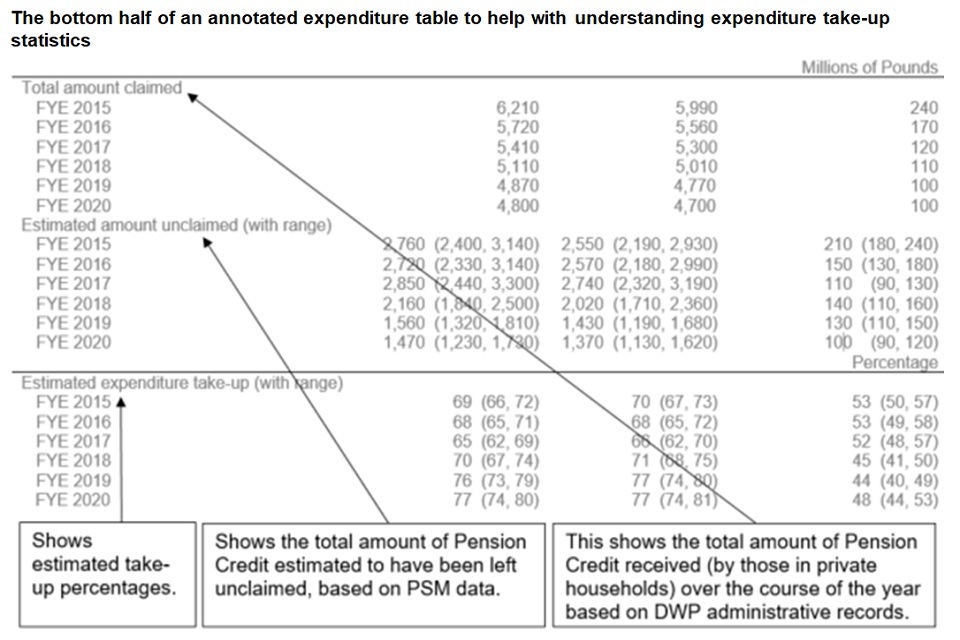Quick guide to published tables and results 2019 to 2020
Updated 26 October 2023
Applies to England, Scotland and Wales
There are 2 types of table presented in this publication:
- contains statistics related to the caseload measure of take-up
- contains statistics related to the expenditure measure
The following illustrations are intended as a guide to interpreting the tables for each benefit. This guide just shows 6 years of data but more years are available in the actual tables. Methodological refinements had been applied to the data from FYE 2017. Therefore, there is a dashed grey line in the tables to indicate this. The examples are for Pension Credit (PC) but the same principles apply for Housing Benefit (HB) (for pensioners) tables.
1. Understanding tables presenting caseload take-up statistics
Key parts of a Take-up caseload table
Pension Credit Overall, Guarantee Credit and Savings Credit only columns – These different columns are to be used to compare statistics for different demographic groupings or benefit components. These will be different on other PC tabs and the HB tables.
Number of recipients – This shows the average number of recipients across the year (in private households) based on the Department for Work and Pensions (DWP) administrative sources (Data on numbers of recipients are published monthly for some benefits, quarterly for others).
Estimated number of entitled non-recipients (with range) – This shows the estimate of people who were not claiming the Pension Credit benefit that they were entitled to based on Policy Simulation Model (PSM) data.
Estimated caseload take-up (with range) – This shows estimated take-up percentages.

2. Understanding tables presenting expenditure take-up statistics
Key parts of a Take-Up expenditure table
Pension Credit Overall, Guarantee Credit and Savings Credit only columns – These different columns are to be used to compare statistics for different demographic groupings or benefit components. These will be different on other PC tabs and the HB tables.
Mean weekly amount claimed – This shows the average weekly amount of benefit actually received (by those in private households) based on DWP administrative sources. (Data on numbers of recipients and amounts received are published monthly for some benefits, quarterly for others).
Mean weekly amount unclaimed and Median weekly amount unclaimed – These averages are used to present a picture of what the ‘typical’ unclaimed amounts are. Mean (average) amounts unclaimed alone may present a distorted picture of the ‘typical’ amount where they are affected by small or very large values. Presenting the median alongside the mean in this way helps present a more balanced picture of the ‘typical’ amounts unclaimed. These values are based on PSM data.

Total amount claimed – This shows the total amount of Pension Credit received (by those in private households) over the course of the year based on DWP administrative sources.
Estimated amount unclaimed (with range) – This shows the total amount of Pension Credit estimated to have been left unclaimed, based on PSM data.
Estimated expenditure take-up (with range) – This shows estimated take-up percentages.

